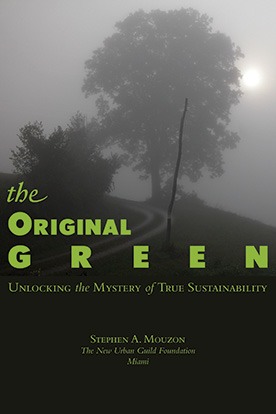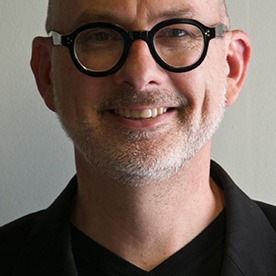search the Original Green Blog

An old-style selfie… the Photoshop version. And that’s Sally on the right, on the first day I met her when Wanda brought her home from North Carolina.
Most architects chart their own path, but Wanda has changed my career path on so many occasions that it’s almost more her story than it is mine. We got married after my first year in architecture school, and while it seems unthinkable judging from pictures of us like the one above, she already had advanced degrees (microbiology and bacteriology) before I graduated from high school… due in part to the fact that she was really smart and graduated early.
But in any case, Wanda would entertain herself in the evenings by coming down to the studio where we were all slaving away on our projects, and got intimately acquainted with what an architecture education was all about. She showed up at all my juries that occurred when she was off work, and eventually asked me this question: “In all branches of biology, and indeed of all science, there are standards to which ideas must measure up, otherwise they are discounted. At their core is the scientific method. Buy you guys in your juries do better or worse seemingly based solely on who is the best debater. Why is that? Is there no standard in architecture by which you can say ‘this is better than that?’”
I had no answer. Nor did my professors. They all talked about genius, creativity, and freedom of expression, but only once in my academic career did I have any conversations with a professor who even hinted at anything that could be considered standards of goodness in the built environment. That professor was Dan Woodfin, who just retired from Ball State this year. He was my thesis advisor and a big advocate of pattern languages. I was fortunate to meet the author of the idea, Christopher Alexander, briefly many years later just after creating his Athena Medal graphic from a bronze casting at the Congress for the New Urbanism. I remain good friends with one of his close colleagues, Michael Mehaffy, to this day. The idea of languages of patterns have been invaluable to me throughout my career, and lies at the foundation of the idea of living traditions.
But back to Wanda. On the day after Thanksgiving 1980 she and I were at my parent’s home in Huntsville, Alabama. We had eaten too much the day before, so she and I, along with my sister Susan and her boyfriend at the time, ventured out to Mooresville, Alabama to walk off some turkey because Huntsville was completely unwalkable in those years. I’ve told this story several times on this blog, most recently here, but I’ve told it as my questions to myself. In reality, Wanda was asking several of the questions as I recall it now. “Steve, your professors tell you you’re the greatest generation of architects ever because you have computers and your builders have bigger power tools, but how could these simple farmers and tradespeople have built a better town in 1818 than the best of you can today? I had no answer. But I took the mystery home with me, feeding it and watering it until the answer opened up almost a quarter-century later.
A year after that Thanksgiving, we were lying in bed about to go to sleep when she asked me a question that again rocked my career: “Why is it that you refuse to design anything that anyone else I love would love?” “Do I?” “Of course!” “How do you know?” “Have you ever listened to non-architects talk about architecture?” “No, our professors tell us that we should educate our clients!” “Well, if you’d listen to some of them, you might actually learn something!” And so that began a decades-long quest to try to figure out what non-architects actually love, and why. Along the way, I discovered that lovability is actually the first foundation of sustainable architecture. If it can’t be loved, it won’t last.
I could go on for hours with all the ways Wanda has redirected my career path, but this post would be far too long. Here’s just one more: We were standing in the parking lot of a grocery store in the late 1990s when she said “in the medical profession, I see many doctors who live lavish lifestyles, but when they retire, they have nothing left to sell because the only thing they ever had to sell was their time. And if they keep up that lifestyle, they very quickly come to poverty. You could do the same. You should instead think of creating tools useful to many people which you can build once and sell many times. And over the two decades since, that is exactly what we have done. At our core, we are now tool-makers, hoping to build things that will benefit many people we will never meet, in places we may never go, both during our lifetimes and beyond our time. That’s our hope, and we’re sticking to it.
~Steve Mouzon
One more thing… I’m delighted to be participating in a blogoff again! This one is ArchiTalks, organized by Lora Teagarden, and this week's topic is career path. I’ll update the links tomorrow as more posts come online. Enjoy the reads!
Jeff Echols - Architect Of The Internet (@Jeff_Echols)
Well, How Did I Get Here (Again)
Lee Calisti, AIA - Think Architect (@LeeCalisti)
a paved but winding career path
Eric T. Faulkner - Rock Talk (@wishingrockhome)
Career - The News Knows
Michele Grace Hottel - Michele Grace Hottel, Architect (@mghottel)
#architalks 41 "Career Path"
Brian Paletz - The Emerging Architect (@bpaletz)
A Winding Path
Drew Paul Bell - Drew Paul Bell (@DrewPaulBell)
Career Path
Jeffrey Pelletier - Board & Vellum (@boardandvellum)
Career Path of an Architect (And Beyond)
Jim Mehaffey - Yeoman Architect (@jamesmehaffey)
Career Path(s)
Mark Stephens - Mark Stephens Architects (@architectmark)
Career Path
Actually, there’s another “one more thing” … Walk Appeal is the book Wanda and I are working on now. Please feel free to subscribe for updates!



